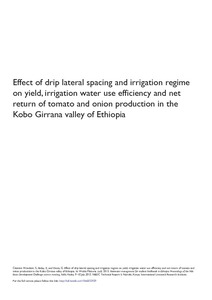Resource information
The irrigation system in Kobo-Girrana valley is extensively developed into modern drip irrigation using ground water sources. Tomato and onion are among the major vegetables grown under drip irrigation. However, the drip lateral spacing is fixed to 1m for all irrigated crops. This lead to low crop water productivity, loss of land, less net return income and un-optimized irrigation production. An on-station experiment was conducted to determine the effect of drip line spacing and irrigation regime on yield, irrigation water use efficiency and net return income. The experiment was carried out for two consecutive irrigation seasons in 2010/11 and 2011/12 at Kobo irrigation research station. The experimental treatments were: two lateral spacing of single row and double row corresponding to each test crop and three irrigation regime (Kp = 0.8, 1.0 and 1.2). The results revealed that an interaction effect between the lateral spacing and irrigation regime was obtained in marketable yield and water productivity of test crops. Application of 0.8 Kp with 2m lateral spacing and 1.2 Kp with 1m lateral spacing provided relatively higher marketable yield of tomato and onion, respectively. Similarly, high water productivity was recorded with same irrigation depths and spacing regimes as to the yield. This result generally revealed that one lateral design for each two plant rows gave high net income than the one lateral design for each one plant row for drip irrigated fresh marketable yield of onion and tomato. An optimized production and irrigation efficiency can be attained by applying irrigation depth adjusted by the given pan coefficients and drip lateral spacing in Kobo areas.



